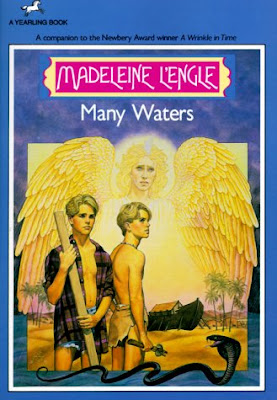I know
that An Acceptable Time fits
somewhere into Madeleine L’Engle’s time series, but I was raised on just the
four that focus on the immediate Murry family.
While I suppose I’ll get around to An
Acceptable Time at some point, as of now, I’m still used to thinking of Many Waters as the end of the line.
A bit of
a companion novel to the other three, Many
Waters follows, not Meg or Charles Wallace, but the other two Murray kids,
twins Sandy and Dennys. It’s set between
A Wrinkle in Time and A Swiftly Tilting Planet, and it sees
the 15-year-old twins accidentally wandering into one of their dad’s
experiments and being flung through time and space into Earth’s antediluvian
days. In the time before the flood,
Dennys and Sandy of course meet Noah and his family, and as they try to find a
way home/not do anything to interfere with history, they catch the attention of
the otherworldly Seraphim and Nephilim.
In the
biblical story of Noah, I don’t think there’s more than one or two verses that
mention the Seraphim and Nephilim, but L’Engle mines a great deal of plot from
those scant lines. She paints an
intriguing picture of the pre-flood world, populated by humans, now-extinct
animals (household mammoths,) more fantastical creatures (griffins and “virtual”
unicorns,) and beings with celestial origins, including those who’ve since
fallen (Seraphim and Nephilim.) Much is
made of the Nephilim’s practice of taking a liking to human women and fathering
children by them, and I like how members of both races can take either their
natural shape or that of a specific animal.
It all comes together to make a story that’s part sci-fi, part fantasy,
and part Bible story.
And in
the middle of it are Sandy and Dennys.
Neither boy is as interesting as Meg or Charles Wallace, but that in
itself adds a new wrinkle to the plot.
The twins aren’t as apt as their siblings to believe in being thrown
backwards through time, let alone the fantastical things they see once they get
there, so it’s neat to see them grapple with what’s happened and try to
reconcile it with their experience of the world thus far. The plot also takes the smart step of
separating them for a good chunk of the earlier action. In addition to increasing the storyline
space, this helps us get to know both boys better, which is important. The twins are relatively minor characters in
the first three books, known more for their contrast with Meg and Charles
Wallace than for themselves, and to the extent that we do know them, it’s definitely as a matched set. Putting them in different situations with
different characters helps differentiate them and gives us a crash course in
understanding them as individuals before they’re brought back together as the
bigger stuff kicks off.
Although
it’s my least favorite of the four books, there’s plenty to like here,
especially for readers who are well-acquainted with the story of Noah. I appreciate the time L’Engle takes to offer
a specific view of everyone in Noah’s household, and I give her credit for
doing something different here – really, even though it’s a series, all four
books take remarkably different approaches to their fantastical/sci-fi
elements, which is rare. In L’Engle’s
world, there are many varied wonders to be seen.
Warnings
Implied
sexual references, violence, drinking, and thematic elements.

No comments:
Post a Comment